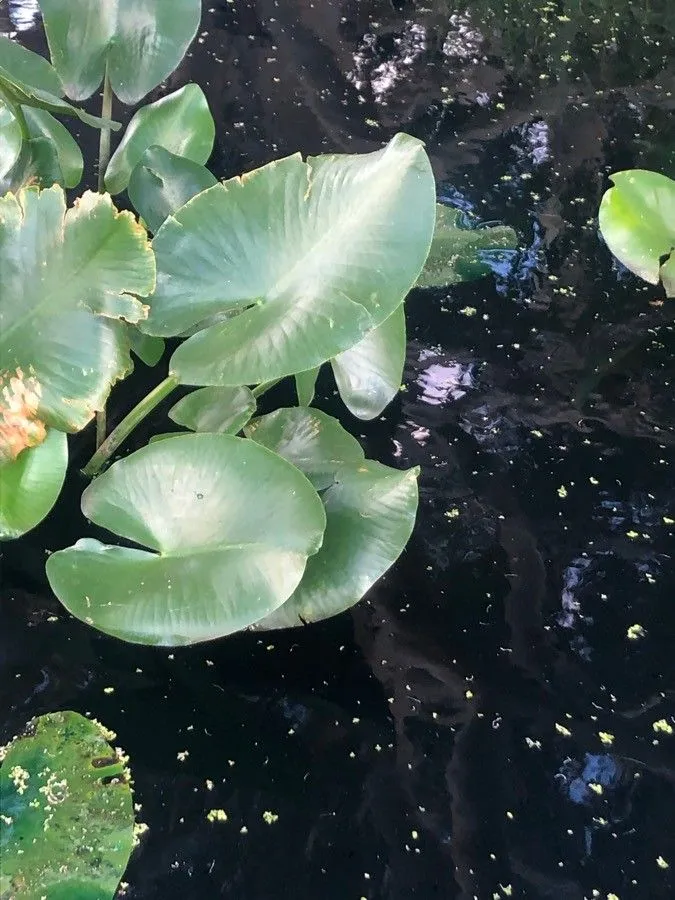
Author: (Aiton) W.T.Aiton
Bibliography: Hortus Kew. 3: 295 (1811)
Year: 1811
Status: accepted
Rank: species
Genus: Nuphar
Vegetable: False
Observations: SE. Canada to E. Mexico, Cuba
The Spatter-dock, scientifically known as Nuphar advena, is an aquatic plant that thrives in the regions extending from Southeastern Canada to Eastern Mexico, and even flourishes in Cuba. First described in the authoritative botanical reference “Hortus Kewensis” in 1811, under the editorship of William Townsend Aiton, this species has captured the interest of botanists and horticulturists for centuries.
Belonging to the family Nymphaeaceae, the Spatter-dock is a perennial plant that typically inhabits ponds, lakes, and slow-moving streams. The plant is known for its robust floating leaves, which are heart or oval-shaped and can reach up to 40 cm in length. The leaves rest on the water surface, creating a lush green mat that provides shelter for aquatic wildlife.
One of the most striking features of the Spatter-dock is its distinctive yellow flowers, which emerge on stiff, upright stalks above the water level. Each flower is composed of six petal-like sepals and numerous yellow petals inside, forming a globe-like appearance. These vibrant blooms are not only visually appealing but also play a crucial role in the plant’s reproductive process, attracting a variety of pollinators such as bees and beetles.
The plant’s rhizomatic root system anchors it to the lake or pond bed, allowing it to spread and establish dense colonies. These roots also help stabilize the sediment, preventing erosion and contributing to the overall health of the aquatic ecosystem.
The Spatter-dock serves as a vital part of its habitat, providing food and covering for numerous aquatic animals, including fish, amphibians, and insects. The plant’s presence can indicate a healthy, balanced aquatic environment, making it a valuable species for ecological studies and water garden enthusiasts.
In summary, Nuphar advena, or Spatter-dock, is a fascinating aquatic plant with a wide natural range from Canada to Mexico and Cuba. Its beautiful yellow flowers, floating leaves, and significant ecological role make it an important and interesting subject of study for botanists and nature lovers alike.
Eng: spatter-dock, yellow pond-lily, large yellow pond-lily, broadleaf pond-lily, spatterdock
Fra: nénuphar à feuilles émergentes, nénufar à feuilles émergentes, nénuphar d’amérique
Swe: sextalig näckros
Cym: lili’r-dŵr felen ddeilsyth, lilïau’r-dŵr melyn deilsyth
En: Spatter-dock, Yellow pond-lily, Large yellow pond-lily, Broadleaf pond-lily, Spatterdock
Fr: Nénuphar à feuilles émergentes, Nénufar à feuilles émergentes, Nénuphar d’Amérique
Sv: Sextalig näckros
Cy: Lili’r-Dŵr Felen Ddeilsyth, Lilïau’r-Dŵr Melyn Deilsyth
© copyright of the Board of Trustees of the Royal Botanic Gardens, Kew.
© copyright of the Board of Trustees of the Royal Botanic Gardens, Kew.
© copyright of the Board of Trustees of the Royal Botanic Gardens, Kew.
Taken Aug 18, 2020 by Diego Alex (cc-by-sa)
Growth form>: Bunch
Growth habit>: Forb/herb
Growth rate>: Moderate
Ph maximum: 7.3
Ph minimum: 6.1
Family: Myrtaceae Author: (F.Muell.) K.D.Hill & L.A.S.Johnson Bibliography: Telopea 6: 402 (1995) Year: 1995 Status:…
Family: Rubiaceae Author: Pierre ex A.Froehner Bibliography: Notizbl. Bot. Gart. Berlin-Dahlem 1: 237 (1897) Year:…
Family: Sapindaceae Author: Koidz. Bibliography: J. Coll. Sci. Imp. Univ. Tokyo 32(1): 38 (1911) Year:…
Family: Asteraceae Author: A.Gray Bibliography: Pacif. Railr. Rep.: 107 (1857) Year: 1857 Status: accepted Rank:…
Family: Fabaceae Author: Medik. Bibliography: Vorles. Churpfälz. Phys.-Ökon. Ges. 2: 398 (1787) Year: 1787 Status:…
Family: Aspleniaceae Author: (Cav.) Alston Bibliography: Bull. Misc. Inform. Kew 1932: 309 (1932) Year: 1932…